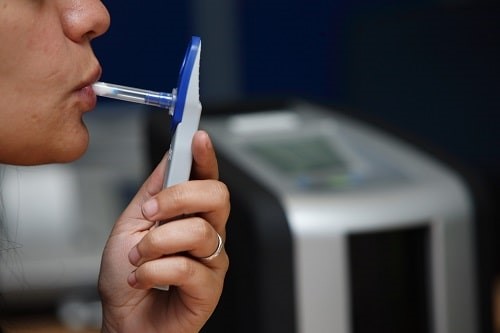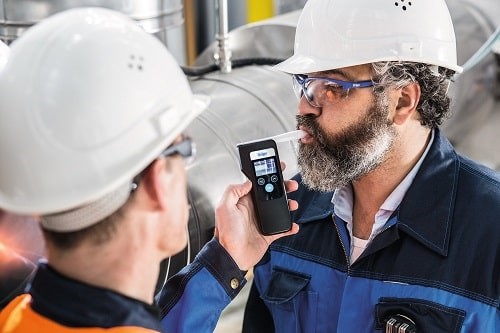Recent research shows the majority of employees support workplace testing for drugs and alcohol as part of wider measures to keep everyone safe at work, and developments in testing technology mean the process is now simpler, faster and less invasive for all concerned.
Features
Time for testing: drugs and alcohol
Over recent years, there has been a gradual escalation in reports of substance use, whether drugs or alcohol, which has a clear effect on employee safety in the workplace. Publicity of this trend was at its height during the pandemic, but the problem hasn’t gone away and furthermore there is evidence to suggest that mental health – a condition which according to the charity Mind, affects one in four each year in the UK – and substance abuse may be linked.
There have been a number of pieces of research that have previously explored this link. These include a study by the Priory Group, a provider of mental healthcare in the UK, which has reported that 70 per cent of people with mental health disorders who engage in community healthcare resources have substance abuse issues.
 Nearly three-quarters (74 per cent) of those asked in a recent survey are in favour of all employees in the organisation being tested for drugs and alcohol. Photograph: Draeger Safety UK
Nearly three-quarters (74 per cent) of those asked in a recent survey are in favour of all employees in the organisation being tested for drugs and alcohol. Photograph: Draeger Safety UK
This is further supported by the Mental Health Foundation, which has stated that people with severe mental illness are more likely to have alcohol problems.
It is therefore perhaps not surprising that research for the Drager Safety at Work Report 2023 found that the overwhelming view of respondents was that testing for drugs and alcohol should be part of a wider safety at work initiative. Nearly three-quarters (74 per cent) of those questioned are in favour of all employees in the organisation being tested for drugs and alcohol – increasing to 80 per cent in the oil and gas/renewables sector.
These findings build on and reinforce the research carried out for last year’s Drager Safety at Work Report 2022, which found that the vast majority of workers would comply with a corporate alcohol and drug testing policy – 83 per cent of workers sampled – as they believe it is in everyone’s interest to be safe at work.
Furthermore, another area specifically explored in the survey was the impact of the current cost-of-living pressures on the wellbeing of employees.
When asked to what extent cost of living pressures and financial difficulties are affecting mental health and wellbeing, just over half (51 per cent) of respondents report that poorer mental health affects their sleep so that they are sometimes more tired at work; while 45 per cent report that it makes them less able to concentrate and 42 per cent say that they are less productive.
 Dave Head: "We know first-hand how important it is to handle the subject sensitively, with dignity and respect."
Dave Head: "We know first-hand how important it is to handle the subject sensitively, with dignity and respect."
There is little doubt these pressures have the potential to cross from the mental to the physical in terms of risking a negative impact on safety at work through performance impairment.
It is therefore perhaps no wonder that more than three in five (63 per cent) of all respondents think an increase in anxiety and depression in the workplace may have a negative impact on safety at work. This is higher among those with anxiety and depression (72 per cent), among the under 35s (68 per cent) and among managers (67 per cent) but less pronounced in the utilities sector (56 per cent).
Given the links between mental health and substance abuse, it is perhaps of little surprise that Drager has seen an increase in companies that are considering introducing drug and alcohol testing in their business.
Drager itself introduced an enhanced drug and alcohol testing policy across its UK business in July 2022, whereby everyone from the managing director to apprentices is now eligible to be included in randomised testing.
The company therefore knows first-hand how important it is to handle the subject sensitively, with dignity and respect. If staff members should have any concerns – for example, regarding the impact of prescribed medications, or due to addiction problems – they are encouraged to talk to their managers so they can be given help and support.
Our research indicates that drug and alcohol testing, and the factors which may contribute to mental health problems, are becoming more commonplace and that substance testing is not just a legacy from the pandemic but a long-term requirement for health and wellbeing in the workplace.
For more information see: www.draeger.com/en_uk/Safety/Drugs-Alcohol-Testing-At-Work
UK airport: An example of drug and alcohol testing in practice
Introduction/background: Workplace drug and alcohol testing
Workplace drug and alcohol (D&A) testing is becoming an increasing area of focus for many businesses, and issues of concern are not only limited to illegal drug and excessive alcohol consumption, but also include prescribed drugs, which can affect people’s responsiveness, decision-making capabilities, and mental and physical fitness for work.
Furthermore, the problem is not confined to job roles that might initially be considered more obviously ‘high risk’, such as heavy machinery operators, heavy goods vehicle drivers or other safety-critical roles. Take, for example, a member of staff driving other colleagues to a meeting; even a low chance of drug or alcohol-related impairment would put colleagues at risk.
The customer
A UK airport employing around 150 people, plus additional contractors, had brought in a D&A testing policy in 2017, but the implementation had been problematic.
The original testing programme depended on an external contractor that could be called to site to undertake D&A testing (using a urine sample) if there were to be an incident or a suspicion of someone working under the influence of either.
Should a requirement for D&A testing be needed, an urgent call was made to the contractor, and it would then normally take at least an hour for the testing professionals to arrive on site to conduct the urine test, by which point it was usually too late to detect any causal link to drugs or alcohol. The service also came at a significant cost.
Action required
The airport’s policy and approach to D&A testing was brought into sharp focus when the airport’s health and safety manager was notified by a team member about a colleague who was suspected to be working while under the influence of alcohol.
 Oral fluid tests – which test saliva – are far less intrusive than urine testing. Photograph: Draeger Safety UK
Oral fluid tests – which test saliva – are far less intrusive than urine testing. Photograph: Draeger Safety UK
The colleague in question was in a risk-critical role at the airport, and it was imperative that the allegation be investigated properly in order to ensure safe operations, and also safeguard the wellbeing and safety of other colleagues.
As per the airport’s policy, the staff member’s line manager raised the concerns with him, giving him a chance to respond. He denied there was any issue.
However, with reasonable grounds to suspect there was a problem, it was mutually agreed that a testing programme would be brought in for the staff member. At the same time, the HR department provided pastoral support.
As it was impractical and too costly for the external company to be used on a daily basis, the airport bought an oral fluid drug testing device from safety technology leader, Draeger Safety UK which has been used extensively with the emergency services, the military, airlines and major industrial conglomerates to provide safety solutions to organisations of all sizes.
These oral fluid tests – which test saliva – are far less intrusive than urine testing, and scientific studies have proven that the saliva analysis method is also highly reliable. With just one test, the device can screen for substances from six to eight different drug categories: cocaine, opiates, amphetamines, methamphetamines/designer drugs, benzodiazepine (e.g. in medications) and cannabis (THC) as well as methadone and ketamine.
Given the high-risk nature of the role of the individual concerned within the airport, it was agreed that a zero tolerance approach would be taken, and so testing using the saliva method was undertaken every morning on arrival at work for six weeks; this consisted of the staff member blowing a short breath into the device.
The airport health and safety manager comments: “It was extremely simple and hygienic to operate – the device made it clear when the person should start breathing and when they should stop, and a reading was displayed a few seconds later, together with a traffic-light system showing whether no alcohol, some alcohol, or a level of alcohol over the legal limit was detected. “Each test was clear, which was a great relief to all concerned, and we subsequently reverted to random testing.
“However, sadly, shortly after this, a randomly-timed test revealed the same person to be over the prescribed limit for alcohol detection as defined by the company policy.”
The individual was suspended immediately to allow him to seek help via his doctor and support meetings. While doing so, the company continued to support him, ensuring he remained on full pay, and checking in with regular welfare calls. After two weeks, he returned to work, but shortly afterwards decided to leave his job.
“It was a very sad case to be involved in, but when you consider the risks involved had we not been able to identify the issue and take action, it’s unthinkable,” concluded the airport health and safety manager. “It was a huge relief to be able to conclusively know what we were dealing with and be able to test so frequently and easily.”
A whole new process
The experience prompted a complete review of the airport’s D&A policy. This resulted in the issue of a new, revised D&A policy, which now includes random tests across all departments on a quarterly basis, which can then be backed up with comprehensive laboratory-based confirmatory testing if required.
Additionally, another significant change is the introduction of compulsory D&A testing for all new starters prior to joining the company.
“In the past, we only required a medical after someone had joined,” explained the airport health and safety manager. “Now we conduct a routine drug and alcohol test before any employment offer is made.
“Drug testing is carried out using the oral fluid (saliva) drug testing device which uses a swab from the person’s mouth placed in the test device. No power source is needed, which means it is portable, hygienic and can be used anywhere – an important consideration on a site such as ours.”
The non-invasive, hygienic, oral fluid test, which takes 3–5 minutes to complete, will conclusively prove if one or more of five substance classes are present, simultaneously: Cocaine (COC), Opiates (OPI), Amphetamines (AMP), Methamphetamine (MET, also known as ‘Designer Drugs’, e.g. ecstasy, MDMA), and Cannabis (THC). It is highly accurate and reliable.
And the new D&A policy is already proving to be effective: “We had interviewed and planned to employ a new starter, but during our routine testing prior to offering him the position, the test showed the presence of a Class A drug,” explained the airport health and safety manager. “Faced with the indisputable proof, he immediately admitted he was a regular recreational drug user and had taken cocaine two days previously. It was clear that we could not – and would not – employ him.”
In conclusion
“We want to be fair and measured, and we’re keen to support colleagues that are struggling with personal issues or mental health problems,” adds the airport health and safety manager. “But the safe operation of the airport must be our priority. It’s a risky enough operation without the worry of people being impaired in their work, and we have a duty of care to all those on site, both staff and the general public.
“It’s important to have a testing policy which also provides support and pastoral care, and we take our responsibilities as an employer very seriously in this regard. But at the same time, we need to be able to be confident in both a positive and negative test result, and the Dräger drug and alcohol testing technology empowers us to have this confidence and keep people safe as a result.”
Dave Head is head of safety marketing at Draeger Safety UK
FEATURES

Pursuing workplace wellbeing through authentic leadership
By Dr Audrey Fleming, British Safety Council on 26 April 2024
By being open, honest and vulnerable in their interactions at work – and genuinely seeking and valuing the input of employees – leaders can develop a workplace atmosphere where trust and respect flourish, in turn supporting the wellbeing, engagement and performance of their teams.

Out in the field: why lone worker monitoring is key
By Rebecca Pick, Pick Protection on 26 April 2024
People working away from a fixed base out in the field may need to quickly summon assistance in an emergency, but it’s important to choose the right communications and alarm technology for their needs.

Why line managers play a vital role in workplace wellbeing
By Marcus Herbert, British Safety Council on 03 September 2023
The behaviours of line managers can have a positive or negative impact on employee health, wellbeing and engagement, so it’s vital managers get staff feedback on whether their management style is supportive or negative, and have regular check-ins so workers can raise concerns about their wellbeing.



